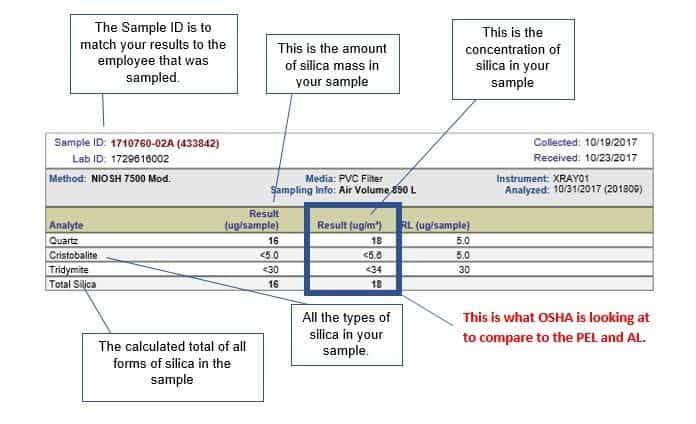Interpreting silica lab results can be a bit overwhelming, so let’s break it down to make it easy. Doctorates look great on resumes but certainly aren’t needed to interpret silica sampling results.
First things first.
Conduct sampling and send your results to a qualified lab. Pssst… if you need help with this, we do it all the time. Request a proposal.
Results are in: now what?
Here is the anatomy of a silica lab report.

Decoding Results for General Industry:
But what does it all mean?
The new OSHA silica standard (1910.1053) sets the Permissible Exposure Limit (PEL) at 50 µg/m3 and the Action Level at 25 µg/m3. These are for average exposures over an 8-hour shift.
Regardless of the results, you should do the following:
- Notify the employee that was sampled of the results within 15 business days and maintain the records as required by OSHA (29 CFR 1910.1020). If results are greater than the Action Level or PEL, tell them what you are going to do in order to reduce exposures.
- Also – you have to notify all affected employees (the ones in the area or that do the same job, they just didn’t get sampled) of results in writing or by posting in visible areas (such as break rooms). If results are greater than the Action Level or PEL, include planned actions to reduce exposures in the notification.
- Don’t forget you have to Conduct general silica awareness training
If your results are less than the Action Level (< 25 µg/m3):
- Congratulations! You do not need to sample this particular task or exposure group again.
If your results are greater than the Action Level but less than the PEL (between 25 µg/m3 and 50 µg/m3) you need to:
- Provide medical surveillance for employees that perform that task and are exposed to silica more than 30 days per calendar year.
- Repeat monitoring at least every 6 months – If an exposure group gets two consecutive results (more than 7 days between sampling events) less than the Action Level, monitoring may be discontinued for that group.
If your results are greater than the PEL (> 50 µg/m3) you need to:
- Provide medical surveillance for employees that perform that task and are exposed to silica more than 30 days per calendar year.
- Select and implement appropriate engineering controls to reduce exposures. And you can’t assume the new controls work, you have to resample to verify they are working.
- Provide appropriate respiratory protection as per 29 CFR 1910.134
- Repeat monitoring at least every 3 months
- If an exposure group gets two consecutive results (more than 7 days between sampling events) less than the PEL but greater than the Action Level, monitoring may be reduced to at least every 6 months for that group.
- If an exposure group gets two consecutive results (more than 7 days between sampling events) less than the Action Level, monitoring may be discontinued for that group.
Decoding Results for Construction: But what does it all mean? The new OSHA silica standard (1926.1153) sets the Permissible Exposure Limit (PEL) at 50 µg/m3 and the Action Level at 25 µg/m3. These are for average exposures over an 8-hour shift. Regardless of the results, you should do the following:
- Notify the employee that was sampled of the results within 5 business days and maintain the records as required by OSHA (29 CFR 1910.1020). If results are greater than the PEL, include planned actions to reduce their exposures.
- Also, you have to notify all affected employees (the ones in the area or that do the same job, they just didn’t get sampled) of results in writing or by posting in visible areas (such as job trailers). If results are greater than the PEL, include planned actions to reduce exposures in the notification.
- Conduct general silica awareness training
If your results are less than the Action Level (< 25 µg/m3):
- Congratulations! You do not need to sample this particular task or exposure group again.
If your results are greater than the Action Level but less than the PEL (between 25 µg/m3 and 50 µg/m3) you need to:
- Repeat monitoring at least every 6 months – If an exposure group gets two consecutive results (more than 7 days between sampling events) less than the Action Level, monitoring may be discontinued for that group.
If your results are greater than the PEL (> 50 µg/m3) you need to:
- Select and implement appropriate engineering controls to reduce exposures. And you can’t assume the new controls work, you have to resample to verify they are working.
- Provide appropriate respiratory protection as per 29 CFR 1910.134
- Provide medical surveillance for employees that perform that task and are exposed to silica more than 30 days per calendar year.
- Repeat monitoring at least every 3 months
- If an exposure group gets two consecutive results (more than 7 days between sampling events) less than the PEL but greater than the Action Level, monitoring may be reduced to at least every 6 months for that group.
- If an exposure group gets two consecutive results (more than 7 days between sampling events) less than the Action Level, monitoring may be discontinued for that group.
Need a recap?
- The new OSHA silica standard (1926.1153) sets the Permissible Exposure Limit (PEL) at 50 µg/m3 and the Action Level at 25 µg/m3. These are for average exposures over an 8-hour shift.
- Depending on your industry, you’ll need to notify employees of results within a certain timeframe.
- If your results are greater than the Action Level or the PEL, you’ll need to take the appropriate actions.
Training recommendation for you:
Silica: Implementing the New OSHA Silica Standard (for supervisors)
May 30 at Safex

